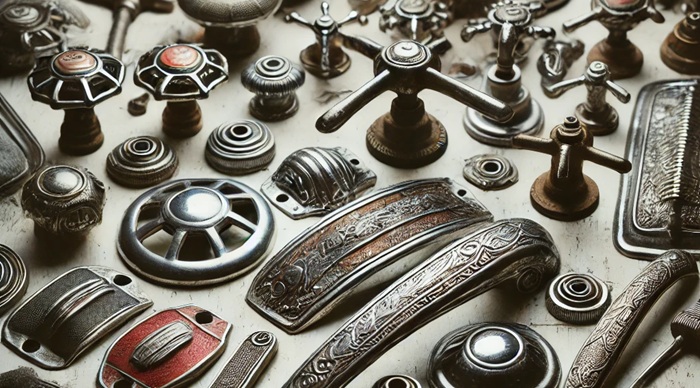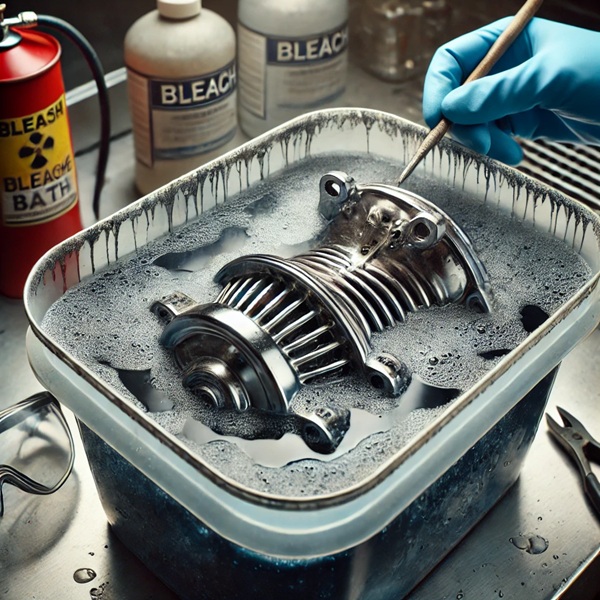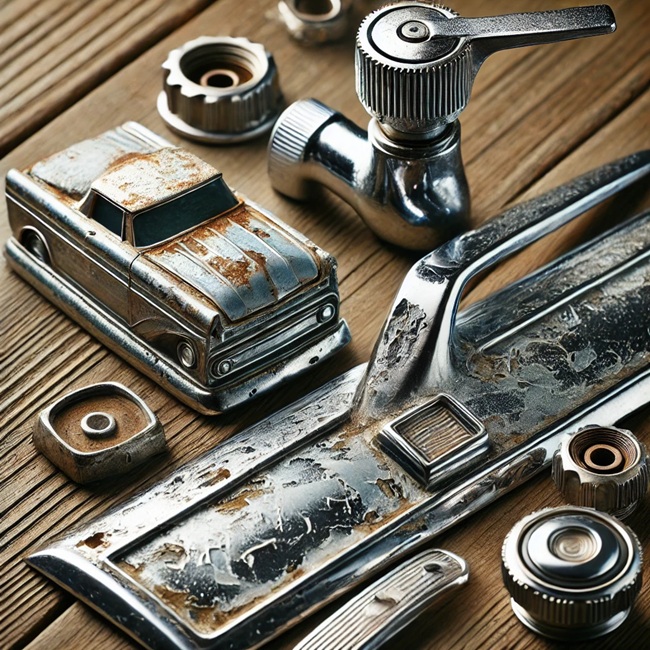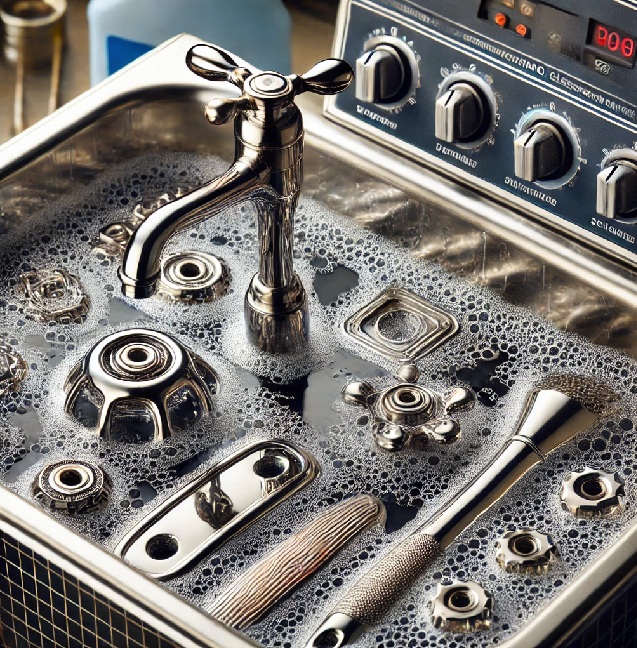Chrome plating represents the direct result of an electrical charge applied to a plating bath consisting of an electrolytic salt solution. This makes the chromium metal detach from the solution and settle on distinct items, usually metallic.
Its primary purpose is to enhance durability and to extend the ability of an object to withstand shock and damage. But at the same time, it also makes an item shiny.
While chrome plating offers a lot in terms of durability and damage resistance still, there are situations in which you might want to remove this extra coat of protection. And this is the moment when you will find out how challenging it is to remove this kind of plating.
Anyhow, we are here to help you, which is why we’ve shared our top tips and tricks on how to remove chrome plating with little to no hassle.
Removing Chrome Plating — 3 Different Ways
Removing chrome plating from plastic and metal parts can be tricky. However, if you know the right steps, you can get the job done right away without damaging the surface.
Below are a few best ways that can be utilized for stripping away the chrome plating…
1 – Use household Products for light chrome
If you want to remove some light coating of old peeling chrome plating from metal and plastic objects, you can use some DIY techniques – there’s no need to make use of the most expensive approaches available on the market.
a. Baking Soda
If your surface only has a thin layer of chrome, you might be able to scrub it via a household abrasive prepared using baking soda.
All you have to do is mix some baking soda with water and achieve a paste of abrasive. Rub this mixture on the chrome surface with the help of a clean cloth. Don’t scrub it for too long, as it might damage the material underneath.
b. Oven Cleaner
This product will de-grease the surface, and after only ten minutes, you will be able to wipe the chrome. You can also use it to deal with fake plastic types of chrome.
Remember that you shouldn’t allow the product to sit too much on the surface, as it might darken it. Instead, use the oven cleaner foam several times in a row until you reach the desired results.
c. Brake Fluid
Brake fluid is another item you might have around, and it can help you remove chrome plating. Use gloves to rub the fluid on the object. Let it sit for around ten minutes and rinse it. Repeat this until the chrome plating is completely removed.
The downside of this is that it might require some time until you altogether remove the plating. Also, keep in mind that brake fluid can dissolve plastic items so use it with caution on such surfaces.
d. Bleaching Powder
A bleach bath is another simple and efficient method to remove a thin light layer of chrome plating that’s already flaking.
To prepare a bleach bath for removing chrome plating, fill a plastic or glass container with undiluted household bleach (containing sodium hypochlorite). Fully submerge the chrome-plated object and let it soak for 24 hours. Over time, the bleach will break down the chrome layer, causing it to peel or dissolve.
Remember that you shouldn’t exceed this time frame, as it can harm the surface.
2 – Apply chemical substances for tough coatings
Various chemical strippers are often used for cleaning tough chrome plating from metal parts. However, it’s good not to use them for plastic as it can damage them.
Some of the common chemicals you can use are:
a. Hydrochloric Acid
Hydrochloric Acid is one of the most potent and corrosive acids you will find on the market to deal with high amounts of chrome plating applied to distinct metals. If you want to adequately clean the surface and remove the entire traces of the chrome plating, you can use between 30 to 40 percent of concentration for the Hydrochloric Acid.
Our advice is to mix three parts of hydrochloric acid with one part of the water in a sturdy bucket to achieve a 30% potent solution.
Submerge the object in the mixture. As soon as you see the layer come off, take the object out and clean the metal surface with the help of mild soap and water. Wash it thoroughly and leave it to dry.
b. Sodium Hydroxide
Sodium hydroxide is a corrosive chemical, great for removing several types of metal coating. If you have a surface made out of carbon steel or ferrous metals, it is best to apply sodium hydroxide instead of hydrochloric acid.
Mix between 8 to 12 ounces of sodium hydroxide with a gallon of water in a heavy-duty plastic bucket.
Soak the object in the mixture and let it sit in the bucket for a while. After all the chrome is removed wash the item with water and mild soap. And, of course, rinse it thoroughly and allow it to dry.
3 – Use reverse electroplating for thicker and stubborn coating
Reverse electroplating is, as the name suggests, a way in which electric current chrome is linked to metal items at a molecular level.
Simply put: it reverses the entire process an object goes through while doing chrome plating. So, if you are looking for an attractive and compelling way to remove chrome or nickel plating, this solution is for you.
Keep in mind that the process is rather complicated, and it involves electrical currents and several toxic and carcinogenic compounds. Even though it appears to be a straightforward method, it is hazardous, and it is best to be performed by a professional.
If you plan to do it yourself make sure you have in-depth knowledge about what you’re doing.
Reverse electroplating can be done with a mix of chromic acid and sulfuric acid, which is added to water in a ratio of 100:1. The solution should be stirred in an immersion tank to ensure each safety aspect.
Decorative objects with light chrome plating require a temperature for the mixture between 85- and 115 degrees Fahrenheit, while hard chrome ranges between 120 and 150 degrees Fahrenheit.
The last step of this process, after reaching the desired temperature for the solution, is to expose the negative charge via a DC power source with the help of the cable. It is meant to pull positively charged external chrome metals from the object. Afterward, rinse the item with water several times.
Can I Use Ultrasonic Cleaner to Remove Chrome Plating?
Although an ultrasonic cleaner alone won’t remove chrome or nickel plating (because these coatings are electrochemically bonded to the metal), you can use it as part of the process if combined with proper chemicals or mechanical stripping.
The beauty of using these professional devices and tools for removing chrome plating is it can help strip the metal as well as plastic parts fast without any risk. Since the process makes use of sound waves, the chances of you damaging the surface are extremely low.
When using an ultrasonic cleaner with a basket, you will have to submerge the surface to be cleaned in a cleaning solution. So, choose an ultrasonic cleaning unit that has an appropriate size basket to fit your parts.
Some cleaning equipment also features a digital timer, which shows the time the unit runs for. You may have to check and ensure the run-time of the timer, particularly if you want the cleaner to do tasks that will take a long time to remove chrome plating.
Moreover, it is highly recommended to use the best cleaning solvents that are designed for ultrasonic cleaners. Avoid using water as this approach is solely efficient for small objects like jewelry, ornaments, or old metal tools.
Is Sanding Off Old Chrome Plating with Sander Machine Safe?
Although chrome is hard and shiny on the surface it has been plated at; it can be stripped and sanded using a high-speed sander machine if you are a professional.
However, if you are not skilled, you may damage the surface by using a sanding machine. Hand sanding using sandpaper can be a better way in that case.
Alternatively, you can use abrasive blasting methods like sandblasting and bead blasting to remove the plating from car parts, tools, industrial machines, miniatures, etc. Be aware that these methods may alter surface texture so choose the appropriate blasting media based on the desired finish.
After stripping, it’s crucial to neutralize any chemical residues and polish or refinish the surface before re-plating or repainting. Under normal conditions, this coated paint over the chrome should last over 2-3 years without any problem.
If you have your auto parts scratched, you can also consider powder coating over chrome to prevent getting them further damaged (due to rust or corrosion) or to avoid looking ugly. However, it’s good to strip off the chrome before you do that.




